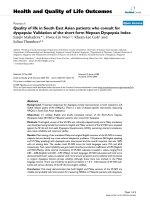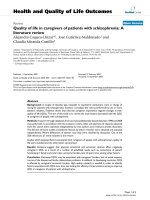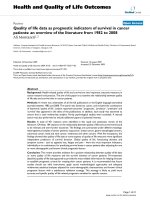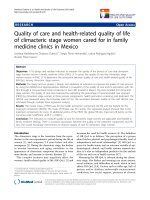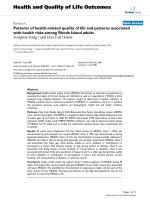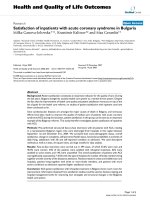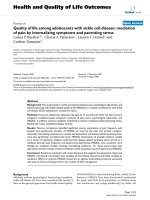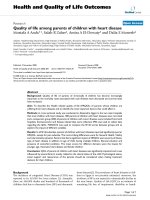báo cáo hóa học: "Quality of life among parents of children with heart disease" ppt
Bạn đang xem bản rút gọn của tài liệu. Xem và tải ngay bản đầy đủ của tài liệu tại đây (223.72 KB, 7 trang )
BioMed Central
Page 1 of 7
(page number not for citation purposes)
Health and Quality of Life Outcomes
Open Access
Research
Quality of life among parents of children with heart disease
Mostafa A Arafa*
1
, Salah R Zaher
2
, Amira A El-Dowaty
3
and Dalia E Moneeb
4
Address:
1
Epidemiology Department, High Institute of Public Health, Alexandria University, Alexandria, Egypt,
2
Pediatric Department, Faculty of
Medicine, Alexandria University, Alexandria, Egypt,
3
Mental Health Department, High Institute of Public Health, Alexandria University,
Alexandria, Egypt and
4
Fellow of Epidemiology, High Institute of Public Health, Alexandria University, Alexandria, Egypt
Email: Mostafa A Arafa* - ; Salah R Zaher - ; Amira A El-Dowaty - ;
Dalia E Moneeb -
* Corresponding author
Abstract
Background: Quality of life of parents of chronically ill children has become increasingly
important as the mortality rates associated with such illnesses have decreased and survival rates
have increased.
Aim: To describe the Health related quality of life (HRQOL) of parents whose children are
suffering from heart diseases and to identify the most important factors that could affect it.
Methods: A cross sectional study was conducted in Alexandria, Egypt in the two main hospitals
that treat children with heart diseases. 400 parents of children with heart diseases were recruited
and a comparison group (400) of parents of children with minor illnesses were included from both
hospitals. Socioeconomic and disease related data were collected, SF36 was used to collect data
regarding the QOL. MANOVA was used to compare the SF-36 scores between groups and to
explore the impact of different variables.
Results: In all SF-36 subscales, parents of children with heart diseases reported significantly poorer
HRQOL, except for pain subscale. The most striking differences were for General Health, Vitality
and role limitation physical. Factors that had a significant impact of HRQOL were severity of illness,
type of heart disease in addition to age of child, having multiple children, financial situation and
presence of comorbid condition. The mean scores for different domains were the lowest for
younger age, rheumatic heart disease and female children.
Conclusion: QOL of parents of children with heart diseases was significantly impaired and it was
influenced by several factors; mainly related to the clinical status of the child. Psychological status,
social support and reassurance of the parents should be considered when making treatment
decision for their children.
Background
The incidence of congenital Heart Diseases (CHD) was
reported to be 8/1000 live born infants [1]. Annually,
there are 400,000 deaths and hundred of thousands of
children died due to rheumatic fever (RF) and rheumatic
heart diseases[2]. The prevalence of heart diseases in chil-
dren in Egypt is not precisely estimated. moreover, the
incidence of RF is not expected to dramatically decline in
the near future. Quality of Life (QOL) is an estimate of
remaining life free of impairment, disability or handi-
Published: 3 November 2008
Health and Quality of Life Outcomes 2008, 6:91 doi:10.1186/1477-7525-6-91
Received: 8 January 2008
Accepted: 3 November 2008
This article is available from: />© 2008 Arafa et al; licensee BioMed Central Ltd.
This is an Open Access article distributed under the terms of the Creative Commons Attribution License ( />),
which permits unrestricted use, distribution, and reproduction in any medium, provided the original work is properly cited.
Health and Quality of Life Outcomes 2008, 6:91 />Page 2 of 7
(page number not for citation purposes)
cap[3]. Chronic conditions put increased stress on the
child and the child's parents and siblings. Children with
any chronic condition have twice the risk of developing
mental health disorders of healthy children, and three
times the risk if they have an accompanying disability[4].
The parents rate their children's QOL to be worse than the
children themselves do[5]. It may be affected by their
expectations for the child and by the fact they have differ-
ent definitions and understanding of a disease and its con-
sequences for the future [6-8].
Although it has been argued that all chronic illnesses can
negatively affect health-related quality of life of the par-
ents of disabled children; each disease present unique
challenges,[9] for example, parents of asthmatic children-
have poor QOL especially in their emotional domain
affecting their social life[10]. Regarding parents of cancer
children, it was found that they have high levels of anxiety
and depression especially in the months immediately
after diagnosis of cancer[11]. Studies of parents of epilep-
tic child have showed that their major concern was regard-
ing the child's seizures, loss of consciousness, ill effects of
anti-epileptic drugs and their only major concern in fam-
ily life was that having an epileptic child put an added
strain on their marital relationship[12].
The finding on QOL among parents of disabled children
are contradictory, in addition little is known about the
identification and quantification of determinants of QOL
among parents of children with heart diseases. The
number of studies conducted are very scarce and non of
them was carried out on a developing country like Egypt.
Hence, this work was undertaken to describe the QOL of
parents of children with heart diseases and to identify the
most important factors that had an impact on it.
Methods
A comparative cross-sectional design was used in the heart
clinics of the University Children's Hospital (El-Shatby)
and Student's Health Insurance Hospital in Alexandria,
Egypt and the E.N.T, surgery and dehydration clinics of
the same hospitals during the period February through
July 2007. Any cardiac patient irrespective of his age or
residential origin can attend these clinics for assessment,
follow up and management. Our target population
included two groups; the parents of the children with
heart disease who were diagnosed as cardiac patients
(congenital or rheumatic heart disease) and they
amounted to 400 and a comparative equal number from
the parents accompanying their children who were
attending the outpatient clinics for minor illnesses (upper
respiratory tract infection, sore throat, abscess, and
diarrheal diseases). The cardiac clinics for each hospital
receive their patients only two days a week; during which
all parents attending these clinics with their children dur-
ing the period of study were included in our sample. For
each cardiac case, a parent of non cardiac child was
selected randomly. An informed and verbal consent was
obtained from parents before the interview. Study partici-
pants (only one parent) were interviewed in person by
trained interviewers using a structured questionnaire to
elicit information on the current; socio-demographic
characteristics, heart disease related data (type, severity,
onset of diagnosis and treatment, compliance, any accom-
panying morbidity), family related risk data (effect of the
disease on the expenses and spending, how much parents
are concerned for the professional and health future of
their diseased child and their expectations). Severity of
heart disease was checked from the attending physician
and confirmed from the records, it depended on the
symptoms, presence of cardiomegally and pulmonary
hypertension, and the severity of valvular lesions. Finan-
cial situation was elicited by asking parents of cardiac dis-
eased children whether they are complaining of financial
problems because of the increased expenses on their dis-
eased child. The studies' committee for research ethics at
the high institute of Public Health approved the study.
Health-related quality of life
The SF-36 V1, which serves as the generic core of the
QOLIE-89 [13], the translated Arabic form was used to
evaluate HRQL[14]. This 36-item measure is made up of
eight subscales, each evaluating a different domain of
HRQL: physical functioning, physical role, bodily pain,
general health, vitality, social functioning, emotional role,
and mental health. Subscale scores are calculated accord-
ing to standard procedures, yielding score values of 0 to
100; higher scores indicate better quality of life. The eight
subscales can be aggregated into the two composite indi-
ces (Z scores): physical component summary (PCS) score
and mental component summary (MCS) score, which uti-
lize population means and standard deviation to establish
the scores. All PCS/MCS are norm based with the general
population means equal to 50 and the standard deviation
equal to 10.
Analysis
Results were expressed as frequencies, means and stand-
ard deviations. SF-36 subscale scores for the participants
in this study were compared across the two groups of
study using multivariate analysis of variance (MANOVA).
MANOVA was used also to explore the impact of the
socio-demographic, medical and family related factors on
the QOL among parents of the children with heart dis-
ease. The alpha level for MANOVA test was set at 0.05. Sig-
nificant statistics (p < 0.05) were followed by post hoc
analyses to determine which subscale were showing group
differences, and which specific groups were significantly
different from one another. The two composite indices;
Physical component summary and mental component
Health and Quality of Life Outcomes 2008, 6:91 />Page 3 of 7
(page number not for citation purposes)
summary score (PCS & MCS) could not be obtained as we
don't have the measurements for population norms for
the QOL domains in our culture.
Results
1 – General characteristics of the study sample
The total number of the studied cases amounted 800 par-
ents, only 3 refused to participate, their description is
illustrated in table 1. Their ages ranged 20 – 58 years More
than half of the sample were just read and write, those
with secondary and university education represented 30%
and 32% for both groups. More than 90% of our sample
were married house wives. More than two thirds of the
families (71%) were of lower and middle social class. As
regards children; their age ranged from 1 month to 202
months with a mean of 68.5 ± 61.2. There were excess
females in the heart diseased group. Nearly two thirds of
children (67.5%) had congenital heart disease and the rest
(32.5%) had rheumatic heart disease. Those suffered from
severe form of illness constituted the least figure(7.8%)
followed by mild degrees (28.7%), while the highest fig-
ure (63.5%) was among those with moderate degree of
heart disease. Nearly 13% of heart diseased children (51
cases) were complained of accompanied co-morbidity in
the form of Rheumatoid arthritis, upper respiratory tract
infections and Down syndrome. It is worth mentioning
that 98% of the parents of heart diseased children
expressed their concern about future familial, financial
and health adjustment problems of their children. More
than two thirds (70%) complained of financial problems
Table 1: General characteristics of the study sample
Parents of children with Heart disease Parents of children with minor illness
Age Mean & SD, 35.7 ± 20.4 Mean & SD, 34.7 ± 19.8
Education
Read and write 256, 64.0% 213, 53.2%
Primary & preparatory 25, 6.3% 59, 14.7%
Secondary and higher 119, 29.7% 128, 32%
Marital status
Married 378, 94.5% 393, 98.25%
Divorced 3, 0.7% 1, 0.25%
Widowed 19, 4.8% 6, 1.5%
Occupation for Fathers
Manual and trade 309, 77.3% 336, 84%
Employee 88, 22% 64, 16%
Out of work 3, 0.7
Occupation for Mothers
House wives 381, 95.2% 392, 98%
working 19, 4.8% 8, 2%
Children with Heart diseases Children with minor illnesses
Age Mean & SD, 73.2 ± 64.3 Mean & SD, 63.8 ± 57.6
Sex
Males 197, 49% 209, 52.3%
Females 203, 50.7% 191, 47.7%
Grade
Preschool 226, 56.6% 256, 64%
Primary 115, 28.7% 105, 26.3%
Preparatory 37, 9.3% 22, 5.5%
Secondary 22, 5.5% 17, 4.2
Type of disease CHD 270, 67.5% RTI 256, 64%
RHD 130, 32.5% Diarrhea 133, 33.3%
Abscesses 11, 2.7%
CHD Congenital heart disease RHD Rheumatic Heart disease
RTI respiratory tract infection
Health and Quality of Life Outcomes 2008, 6:91 />Page 4 of 7
(page number not for citation purposes)
because of increased expenses as a result of presence of a
disabled child.
2 – Health related quality of life: SF-36 profile
Table 2 revealed that parents of the children with heart
disease had significantly worse mean scores in all HRQOL
dimensions when compared to data from parents of chil-
dren with minor illnesses, except for the bodily pain sub-
scale. The most striking differences were observed in the
vitality subscale (39.66 vs. 75.81) general health (46.25
vs. 73.15) and role physical (39.53 vs. 61.81). The lowest
differences although significant were seen for the physical
functioning (75.76 vs. 79.84) and social functioning
(93.63 vs. 99.88). The overall test statistic was statistically
significant (P < 0.001) for the seven subscales indicating
that there was a relationship between group membership
(parents of children with heart disease and parents of chil-
dren with minor illnesses) and HRQOL. MANOVA indi-
cated a significant impact of age (F = 6.77, p < 0.001), sex
(F = 2.191, p < 0.05), type of heart disease (F = 5.197, p <
0.001), severity of illness (F = 5.848, p < 0.001), the pres-
ence of co-morbid conditions (F = 3.782, p < 0.001),
financial situation of the parents (F = 5.880, p < 0.001),
and number of children (F = 2.243, p < 0.005) on HRQL
of parents of children with heart disease. Education and
sex of the accompanying person of the child were not sta-
tistically significant (F = 1.072, p = 0.357) and (F = 1.33,
P = 0.380) respectively, table 3. Eta square was also pre-
sented in that table which describes the proportion of
total variability attributable to a factor, Table 3.
The results of the univariate analysis are shown in table 4.
Age of the child was associated significantly with poorer
HRQOL in the areas of role physical (F = 7.814, P < 0.05)
and role emotional (F = 15.389, P < 0.05), while child ser
was associated with poorer HRQOL only in areas of vital-
ity (F = 5.036, P < 0.05) and social functioning (F = 4.832,
P < 0.05). Notably, severity of illness had a significant
impact on poorer HRQOL in all QOL domains, also type
of heart disease was associated with poorer HRQOL in all
areas of the QOL domains except social functioning and
emotional well-being. Financial situation of the parents
and associated co-morbid conditions were associated
with significantly poorer HRQOL in areas vitality and
emotional well-being. Physical and social functioning
subscales were affected also by the financing problems of
the parents (F = 8.821, P < 0.05 & F = 13.734, P < 0.001
respectively). The only domain that sound to be affected
significantly by number of children was the social func-
tioning. Parents QOL was worse for female children with
rheumatic heart disease and with severe degrees of the dis-
ease for the corresponding significant domains. With
regards to child age, it was categorized into 3 categories,
less than 6 years, 6–13 years and more than 13 years. It
was noticed that the mean score for QOL was the least for
the lowest age category, it increased to the highest in the
Table 2: Comparison of SF-36 subscales between groups
SF-36 subscales Group SD F statistic P-value
General health Cases 46.25 23.59 277.87 0.000
Controls 73.15 22.03
Physical functioning Cases 75.76 17.11 13.51 0.000
Controls 79.84 14.10
Role limitation due to physical health problems Cases 39.53 34.35 71.67 0.000
Controls 61.81 39.89
Role limitation due to emotional problems Cases 38.25 32.46 69.32 0.000
Controls 58.75 37.03
Vitality (Energy/fatigue) Cases 39.66 23.71 480.42 0.000
Controls 75.81 22.94
Emotional well-being Cases 72.90 16.71 75.24 0.000
Controls 82.67 15.12
Social functioning Cases 93.63 21.31 33.93 0.000
Controls 99.88 2.50
Bodily pain Cases 82.60 11.6 3.57 0.344
Controls 81.80 12.3
X
Health and Quality of Life Outcomes 2008, 6:91 />Page 5 of 7
(page number not for citation purposes)
primary school age category, then during the adolescence
(> 12 years) it worsens again.
Discussion
Heart disease is rated among the most severe of chronic
disabilities among children. Parents of the children with
heart disease may experience higher stress levels than par-
ents of children with other diseases, and may feel great
stress in relation to such things as dilemmas of normality
and social integration [15,16] On the other hand the par-
ents' QOL may be more determined by spouses' satisfac-
tion with each other or parental coping styles than by the
child's handicap [17-19].
Results of this study support the premise that parents of
the children with minor illness experienced a better
HRQOL than those of the children with heart disease. Par-
ents of the children with heart disease reported severe
impairment across multiple domains of QOL including a
lowered sense of well-being with regard to energy and
general health, limitations in function due to physical and
emotional reasons. The greatest mean differences between
parents were found on the vitality, general health and role
limitation-physical scales. As these domains deal with
parents' feeling of physical health including energy and
fatigue, problems of work or other daily activities which
resulting from physical health. These findings were in
agreement with the study carried out among Swedish pop-
ulation which addressed the problems of parents of the
children with heart disease in different areas of the QOL.
It indicated that parents of the children with heart disease
had significantly poorer QOL than parents of the children
with other diseases and those of healthy children[20].
parents of the children with heart disease expressed that
caring load reduced their time/opportunity to unwind,
interfered with family activities and family cohesion, as
well as recreation and socialization activities which in
turn may have negatively affected their QOL. Parents of
children with developmental disabilities showed that
parenting these children is associated with impaired men-
tal health, higher levels of stress, and also impaired phys-
ical functioning [21-24]. These parents accommodated to
their child's needs early on by restricting their social life
and making changes in family routines.
More than 90% of the interviewed parents were the moth-
ers which might explain the result of the present study that
parental sex did not account for the reduced QOL. In con-
trary to the studies of Lawoko S, Wysocki T and Wikblad
K [20,25,26] which indicated that mothers of children
with heart disease reported lower QOL than fathers with a
particularly great impact on the social, physical and psy-
chological subscales. As well, QOL of mothers of children
newly diagnosed with cancers was much worse than
fathers as compared to general population. This may be
because mothers tend to be more involved than fathers in
care-giving and spent extra time caring for their sick child,
more responsible for medication and treatment decisions,
and more likely to stay in hospital with the child.
One of the aims of the present study was to consider the
most important factors which may be involved in the
effect of heart disease on the QOL of the parents. The
present study revealed that severity of illness, type of heart
disease and financial status of the family were associated
significantly with poorer HRQOL in nearly most of the
Table 3: MANOVA general F-test, Factors affecting HRQL.
Factor F statistic P-value Eta squared
Age 6.776 0.000 0.10
Sex 2.191 0.034 0.041
Type of heart disease 5.197 0.000 0.11
Severity of illness 5.848 0.000 0.12
Presence of co-morbid condition (Down syndrome, rheumatic arthritis) 3.782 0.001 0.05
Financial situation 5.880 0.000 0.046
Education of the parents 1.072 0.357 0.017
Parental sex 1.33 0.380 0.015
Number of children 2.243 0.006 0.37
Health and Quality of Life Outcomes 2008, 6:91 />Page 6 of 7
(page number not for citation purposes)
subscales; particularly severity of illness where all
domains were affected. Whereas having multiple children
had an influence only on social functioning. These factors
tend to lay additional physical, emotional and financial
burden on the family reducing their QOL. This was evi-
denced by the impairment in the physical functioning,
vitality, general health, and role physical domains for
those parents as these domains deal with all physical
activities including household activities, bathing, dress-
ing, energy and fatigue. On the other hand the study of
Lawoko S [20] indicated that the reduced QOL was more
determined by such variables as financial burdens, dis-
tress & hopelessness than by the child's sex and illness.
In accordance with our findings which showed a great
impact of the financial situation of the parents on the
physical functioning, vitality, emotional well-being, and
social functioning scales of the QOL, a study of a Swedish
population showed that parents who were concerned
about their finances and with living expenses problems
expressed lower QOL than those without such difficulties
[20].
SF-36 was used several times, among different patients
and in many different cultures, however this was the first
time to use this tool in our developing region for examin-
ing the QOL of parents of cardiac diseased children partic-
ularly rheumatic heart disease which is not a feature of
comparables studies and so is a novel area, which could
enhance and strengthen the outcome of the current work.
Limitations of the study
Our data is representing the children population with
heart diseases in our community as most of such diseased
children are managed in that governmental clinics and
nearly all of them are of the same social class. However,
the points of the weakness should be acknowledged.
Firstly, our data depended entirely on the parents' subjec-
tive assessment of their own QOL which may question its
accuracy. Secondly, the group of children with minor ill-
Table 4: MANOVA Univariate test.
QOL Domain Factor F statistic P-value
Role physical
c
Child's age 7.814 0.005
Role emotional
d
15.389 0.000
Vitality
e
Child's sex 5.036 0.025
Social functionin
g
4.832 0.029
General health
a
Type of heart disease 3.962 0.047
Physical functioning
b
8.540 0.004
Role physical
c
5.951 0.015
Role emotional
d
9.945 0.002
Vitalit
e
3.601 0.044
General health
a
Severity of illness 19.702 0.000
Physical functioning
b
7.156 0.001
Role physical
c
14.047 0.000
Role emotional
d
8.926 0.000
Vitality
e
14.867 0.000
Emotional well-being
f
19.817 0.000
Social functioning
g
14.435 0.000
Vitality
e
Presence of co-morbid condition 4.443 0.036
Emotional well-being
f
15.890 0.000
Physical functioning
b
Financial situation 8.821 0.003
Vitality
e
15.950 0.000
Emotional well-being
f
6.918 0.009
Social functioning
g
13.734 0.000
Social functioning
g
Number of children 3.579 0.029
Influence of significant variables on HRQL domains.
a R
2
= 0.11, b R
2
= 0.53, c R
2
= 0.72,
d R
2
= 0.63, e R
2
= 0.13, f R
2
= 0.15
g R
2
= 0.08
Health and Quality of Life Outcomes 2008, 6:91 />Page 7 of 7
(page number not for citation purposes)
nesses are less homogenous and their clinical status are
much less severe in comparison to heart diseased chil-
dren. In addition to that, the psychological and health sta-
tus of parents of heart diseased children were not
addressed which might have an effect on their QOL. Also
most of the factors that affecting the QOL were non mod-
ifiable (child age and sex, financial problems, type of dis-
ease, and severity).
Implications for practice and research
Our study provides preliminary implications for interven-
tions aimed at improving QOL among parents of children
with heart disease as the family has the primary and the
most important role in the management of such diseases
in children. Such interventions could be in the form of
social support, Psycho-education of parents and other
family members which should go hand in hand with that
of children. Besides educating them issues related to their
illness, developing their parenting skills and their coping
with stress of having a chronically ill child should be
emphasized. Being the first study that was conducted in
our region about HRQOL of health persons; additional
research should be directed at the parents' QOL and the
factors improving or worsening it.
Abbreviations
CHD: Congenital heart disease; RHD: Rheumatic heart
disease; RTI: Respiratory tract infection; RF: Rheumatic
fever; QOL: Quality of Life; PCS: Physical component
score; MCS: Mental component score
Competing interests
The authors declare that they have no competing interests.
Authors' contributions
MA conceived of the study, and participated in its design
and coordination. SZ supervising the field work, and par-
ticipated in writing the paper. AE participated in data col-
lection. DE participated in the sequence alignment. All
authors read and approved the final manuscript.
Acknowledgements
Great thanks and much appreciation should be due to Directors, staff of
nurses in the hospitals and to the participants and field workers where the
current work was conducted for their help and assistance during the field
work.
References
1. Hoffman JI: Incidence of congenital heart disease: Prenatal and
postnatal incidence. Pediatric Cardiology 1995, 106(3):103-13.
2. World Health Organization: The WHO global programme for
the prevention of rheumatic fever and rheumatic heart dis-
ease: Report of a consultation to review progress and
develop future activities. WHO/CVD/00.1, Geneva 1999.
3. Last JM, Spasoff RA, Harris SS, Thuriaux MC, Anderson JB: A diction-
ary of Epidemiology. 4th edition. New York: Oxford University
Press; 2001:148.
4. Swanston H, Williams K, Nunn K: The psychological adjustment
of children with chronic conditions. Clinical approaches to early
intervention in child and adolescent mental health. Adelaide: Australian
Early intervention, Net work for mental Health in Young People 2000, 5:.
5. Vogels T, Verrips GH, Verloove-Vanhorick SP, Fekkes M, Kamphuis
RP, Koopman HM, Theunissen NC, Wit JM: The Proxy problem:
Child report versus parent report in health related quality of
life research. Quality of Life Research 1998, 7:387-97.
6. Parsons SK, Barlow SE, Levy SL, Supran SE, Kalpan SH: Health-
related quality of life in pediatric bone marrow transplant
survivors: according to whom? Int J Cancer Supply 1999, 12:46-51.
7. Sturms LM, Sluis CK, Groothoff JW, Duis HJ, Eisma WH: Young
traffic victim's long-term health-related quality of life: Child
self-reports and parental reports. Arch Phys Med Rehabil 2003,
84:431-6.
8. Sweeting H, West P: Health at age 11: Reports from schoolchil-
dren and their parents. Arch Dis Child 1998, 78:427-34.
9. Epstein I, Stinson J, Stevens B: The effects of camp on health-
related quality of life in children with chronic illness: A
review of the literature. Journal of Pediatric Oncology Nursing 2005,
22(2):89-103.
10. Reichenberg K, Broberg AG: The pediatric asthma caregiver's
quality of life questionnaire in swedish parents. Acta Paediatr
2001, 90:45-50.
11. Grootenhuis MA, Last BF: Predictors of parental emotional
adjustment to childhood cancer. Psycho-Oncology 1997,
6:115-28.
12. Prahbhjot M, Pratibha S:
Correlates of quality of life with epi-
lepsy. Indian J Pediatr 2005, 72(2):131-35.
13. Ware JE, Snow KK, Kosinski M, Gandek B: SF-36 health survey:
manual and interpretation guide. Boston: The Health Institute,
New England Medical Center; 1993.
14. Medical outcome study: 36 item short form survey. [http://
rand.org/health/surveys_tools/mos/mos_core_36item.html].
15. Halldorsdotti S, Karlsdottir SI: Empowerment or discourage-
ment: Women's experience of caring and uncaring
incounters during childbirth. Health Care Women Int 1996,
17:361-79.
16. Goldberg S, Morris P, Simmons RJ, Fowler RS, Levison H: Chronic
illness in infancy and parenting stress: A comparison of three
groups of parents. Journal of Pediatric Psychology 1990, 15:347-58.
17. Sparacino CS, Tong EM, Messias DK, Foote D, Chesla CA, Gilliss GL:
The dilemmas of parents of adolescents and young adults
with congenital heart disease. Heart Lung 1997, 26:187-95.
18. Sjöbu L: Parents of children with cerebral palys in Nordland;
factors connected to their quality of life and coping of the cir-
cumstances around the handicapped child. Arctic Med Res
1994, 53 Suppl 1:30-31.
19. Staab D, Wenninger K, Gebert N, Rupprath K, Bisson S, Trettin M,
Paul KD, Keller KM, Wahn U: Quality of life in patients with
cystic fibrosis and their parents: What is important besides
disease severity? Thorax 1998, 53:727-31.
20. Lawoko S, Soares JJF: Quality of life among parents of children
with congenital heart disease, parents of children with other
diseases, and parents of healthy children. Quality of Life Research
2003, 12:655-66.
21. Weiss SJ: Stressors experienced by family caregivers of chil-
dren with pervasive developmental disorders. Child Psychiatry
Hum Dev 1991, 21:203-16.
22. Fisman S, Wolf L: The handicapped child: psychological effects
of parental, marital, and sibling relationships. Psychiatr Clin
North Am 1991, 14(1):199-217.
23. Dyson LL: Fathers and mothers of school-age children with
developmental disabilities: Parental stress, family function-
ing, and social support. American Journal of Mental Retardation
1997, 102:267-79.
24. Seltzer MM, Greenberg JS, Floyd FJ, Pettee Y, Hong J: Life course
impacts of parenting a child with a disability. American Journal
of Mental Retardation 2001,
106:265-86.
25. Wysocki T, Gavin L: Psychometric properties of new measure
of fathers' involvement in the management of pediatric
chronic diseases. Journal of Pediatric Psychology 2004, 29:231-40.
26. Hedov G, Anneren G, Wikblad K: Self-perceived health in swed-
ish parents of children with down's syndrome. Quality of Life
Research 2000, 9:415-22.
